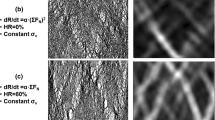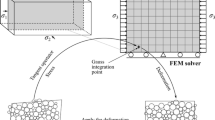Abstract
This paper presents a model that can simulate early rock-forming processes, including the influence of the initial packing of the grains on the subsequent rearrangement that occurs as a consequence of pressure-induced grain damage. The paper is concerned with the behaviour of assemblies of loose grains and the mechanics of early lithification. Consider the concept of shear-induced negative dilatancy, where any shear deformation has a tendency to produce densification even at very low pressures. As shear deformation progresses, positive dilatancy starts to contribute and at the critical state the two effects balance. This concept is encapsulated within the mathematics of the model. The model building scheme is first outlined and demonstrated using a hard particle model. Then, the concept of ‘self cancelling shear deformations’ that contribute to the shear–volume coupling but not to the macroscopic shear deformation is explained. The structure of the hard particle model is modified to include low levels of damage at the grain contacts. A parameter that describes bonding between the grains and possible damage to those bonds is incorporated into a term that, depending on its magnitude, also accounts for frictional resistance between unbonded grains. This parameter has the potential to develop with time, increasing compressive stress, or in response to evolving chemical concentrations. Together these modifications allow densification in the short term, and the formation of sedimentary rocks in the long term, by pressure alone, to be simulated. Finally, simulations using the model are compared with experimental results on soils.










Similar content being viewed by others
References
Baker DW, Chawla KS, Krizek R (1993) Compaction fabrics of pelites: experimental consolidation of kaonlinite and implications for analysis of strain in slate. J Struct Geol 15(9/10):1123–1137
Baud P, Vajdova V, Wong T (2006) Shear enhanced compaction and strain localization: inelastic deformation and constitutive modeling of four porous sandstones. J Geophys Res Solid Earth 111(B12401) 1–7. doi:10.1029/2005JB004101
Bishop JFW, Hill R (1951) A theory of the plastic distortion of a polycrystalline aggregate under combined streses. Philos Mag 42(327):414–427
Cashman S, Cashman K (2000) Cataclaisis and deformation-band formation in unconsolidated marine terrace sand, Humbolt county, California. Geology 28(2):111–114
Chandler HW (1985a) A plasticity theory without Drucker’s postulate, suitable for granular materails. J Mech Phys Solids 33:215–226
Chandler HW (1990) Homogeneous and localised deformation in granular materials: a mechanistic model. Int J Eng Sci 28(8):719–734
Chandler HW, Sands CM (2007a) An optimisation structure for frictional plasticity. Proc R Soc A Math Phys Eng Sci 463(2084):2005–2020
Chandler HW, Sands CM (2007b) The role of a realistic volume constraint in modelling a two dimensional granular assembly. J Mech Phys Solids 55(7):1341–1356
Chandler HW, Sands CM (2009) A graphical method for producing yield surfaces for soils. Géotechnique 59(8):683–690
Chandler HW, Sands CM (2010) Including friction in the mathematics of classical plasticity. Int J Numer Anal Methods Geomech 34:53–72. doi:10.1002/nag.806
Chupin O, Rechenmacher AL, Abedi S (2011) Finite strain analysis of nonuniform deformation inside shear bands in sands. Int J Numer Anal Methods Geomech 36:1651–1666
Cilona A, Baud P, Tondi E, Agosta F, Vinciguerra S, Rustichelli A, Spiers CJ (2012) Deformation bands in porous carbonate grainstones: field and laboratory observations. J Struct Geol 45(SI):135–155
Collins IF, Houlsby GT (1997) Application of thermomechanical principles to the modelling of geotechnical materials. Proc R Soc Lond Ser A Math Phys Eng Sci 453(1964):1975–2001
Cuss RJ, Rutter EH, Holloway RF (2003) The application of critical state soil mechanics to the mechanical behaviour of porous sandstons. Int J Rock Mech Min Sci 40:847–862
Dan G, Sultan N, Savoye B, Deverchere J, Yelles K (2009) Quantifying the role of sandy-silty sediments in generating slope failures during earthquakes: example from the algerian margin. Int J Earth Sci (Geol Rundsch) 98:769–789
Das A, Buscarnera G (2014) Simulation of localized compaction in high-porosity calcarenite subjected to boundary constraints. Int J Rock Mech Min Sci 71:91–104
DiMaggio FL, Sandler IS (1971) Material models for granular soil. J Eng Mech ASCE 97:939–950
DorMohammadi H, Khoei AR (2008) A three-invariant cap model with isotropic-kinematic hardening rule and associated plasticity for granular materials. Int J Solids Struct 45(2):631–656
Ellis S, Darby D (2005) A modified terzaghi consolidation factor for first-order estimation of overpressure resulting from sedimentation: review and synthesis. Math Geol 37(1):115–123
Fokker PA, Orlic B (2006) Semi-analytic modelling of subsidence. Math Geol 38(5):565–589
Gajo A, Muir Wood D (1999) A kinematic hardening constitutive model for sands: the multiaxial formulation. Int J Numer Anal Methods Geomech 23(9):925–965
Gratchev IB, Sassa K, Osipov VI, Sokolov VN (2006) The liquefactino of clayey soils under cyclic loading. Eng Geol 86:70–84
Han G, Dusseault MB (2005) Sand stress analysis around a producing wellbore with a simplified capillary model. Int J Rock Mech Min Sci 42:1014–1027
Hermanrud C, Venstad JM, Cartwright J, Rennan L, Hermanrud K, Bolåas HMN (2013) Consequences of water level drops for soft sediment deformation and vertical fluid leakage. Math Geosci 45:1–30
Holcomb D, Rudnicki JW, Issen K, Sternlof K (2007) Compaction localization in the earth and the laboratory: state of the research and research directions. Acta Geotech 2(1):1–15
Hunter SC (1976) Mechanics of continuous media, 2nd edn. Ellis Horwood, Chichester
Joer HA, Lanier J, Fahey M (1998) Deformation of granular materials due to rotation of principal axes. Géotechnique 48(5):605–619
Mair K, Abe S (2008) 3d numerical simulations of fault gouge evolution during shear: grain size reduction and strain localization. Earth Planet Sci Lett 274:72–81
Miura N (1979) A consideration on the stress-strain relation of a sand under high pressures. Proc Jpn Soc Civil Eng 282(2):127–130
Miura N, Marata H, Yasufuku N (1984) Stress-strain characteristics of sand in a particle-crushing region. Soils Found 24(1):77–89
Mollema PN, Antonellini MA (1996) Compaction bands: a structural anlogue for anti-mode i cracks in eolian sandstone. Tectonophysics 267:209–228
Paterson SR, Tobisch OT (1993) Pre-lithification structures, deformation mechanisms and fabric ellipsoids in slumped turbidites from the pigeon point formation california. Tectonophysics 222:135–149
Pestana JM, Whittle AJ, Gens A (2002a) Evaluation of a constitutive model for clays and sands: part ii clay behaviour. Int J Numer Anal Methods Geomech 26:1123–1146
Pestana JM, Whittle AJ, Salvati LA (2002b) Evaluation of a constitutive model for clays and sands: part I sand behaviour. Int J Numer Anal Methods Geomech 26:1097–1121
Roscoe KH, Burland JB (1968) On the generalised stress strain behaviour of wet clay. In: Heyman J, Leckie FA (eds) Engineering plasticity. Cambridge University Press, Cambridge, pp 535–609
Sands CM, Chandler HW (2010) Yield surfaces and flow rules for deformation of granular materials with a volume constraint. Comput Geotech 37:701–709
Sands CM, Chandler HW (2011) Simulations of cyclic shearing of sand at low effective stress. Géotechnique 61(11):983–992
Sands CM, Chandler HW (2012) Simulating pressure-induced compaction by grain rearrangement. Géotech Lett 2:187–192
Sands CM, Chandler HW (2014) Methods for incorporating particle rearrangement into compaction using thermodynamic approaches. Contin Mech Thermodyn 26(2):183–192
Sands CM, Chandler HW, Guz IA (2010) Developing elasto-plastic models without establishing any expression for the yield function. Numer Anal Methods Geomech 35:932–946
Sands CM, Brown AR, Chandler HW (2011) The application of principles of soil mechanics to the modelling of pastes. Granul Mater 13:573–584
Tsegaye AB, Benz T (2014) Plastic flow and state-dilatancy for geomaterials. Acta Geotechnica
Vesic AS, Clough GW (1968) Behaviour of granular materials under high stresses. J Soil Mech Found Div ASCE 94(SM3):661–688
Wibberly CJ, Yielding G, Di Toro G (2008) Recent advances in the understanding of fault zone internal structure: a review. Geol Soc Lond Spec Publ 299:5–33
Youd TL (1972) Compaction of sands by repeated shear straining. J Soil Mech Found Div ASCE 98:709–725
Yunus Y, Vincens E, Cambo B (2010) Numerical local analysis of relevant internal variables for constitutive modelling of granular materials. Int J Numer Anal Methods Geomech 34:1101–1123
Zhu C, Arson C (2014) A thermo-mechanical demage model for rock stiffness during anisotropic crack opening and closure. Acta Geomtechnica
Ziegler H (1983) An Introduction to thermomechanics, 2nd edn. North Holland, Amsterdam
Author information
Authors and Affiliations
Corresponding author
Rights and permissions
About this article
Cite this article
Sands, C.M., Chandler, H.W. On the Initial Stages of the Densification and Lithification of Sediments. Math Geosci 48, 439–461 (2016). https://doi.org/10.1007/s11004-015-9619-5
Received:
Accepted:
Published:
Issue Date:
DOI: https://doi.org/10.1007/s11004-015-9619-5




